Question
In a cross between a male and female, both heterozygous for sickle-cell anaemia gene, what percentage of the progeny will be diseased? [NEET 2021]
(a) $50 \%$
(b) $75 \%$
(c) $25 \%$
(d) $100 \%$
Answer/Explanation
Ans. (c)
The genotype of both male and female, heterozygous for sickle-cell anaemia gene can be represented as $\mathrm{Hb}^{\mathrm{A}} \mathrm{Hb}^{\mathrm{S}}$ Thus,
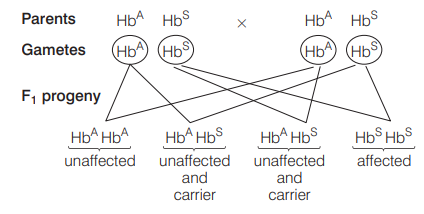
Thus, the percentage of diseased progeny will be 25%
Question
The best example for pleiotropy is [NEET (Oct.) 2020]
(a) skin colour
(b) phenylketonuria
(c) colour blindness
(d) ABO blood group
Answer/Explanation
Ans. (b)
The best example for pleiotropy is phenylketonuria which occurs in humans. In pleiotropy, a single gene can exhibit multiple phenotypic expressions. This gene is called pleiotropic gene. In phenylketonuria, a single gene mutation that codes for enzyme phenylalanine hydroxylase is seen. This manifests itself through phenotypic expression characterised by mental retardation and a reduction in hair and skin pigmentation
Question
Select the correct match. [NEET (Sep.) 2020]
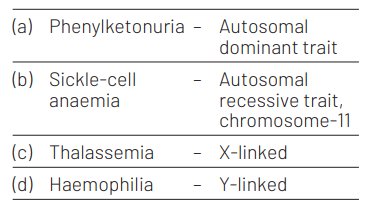
Answer/Explanation
Ans. (b)
Option (b) is correct whereas option (a),(c) and (d) are incorrect because Phenylketonuria is an autosomal recessive disorder.Due to this disorder, enzyme phenylalanine hydroxylase is not synthesised. This enzyme is required for conversion of phenylalanine (PA) into tyrosine. If enzyme production stops, the concentration of PA in body tissues increases, this accumulated PA gets converted into phenyl pyruvic acid which is responsible for damaging the brain.Thalassemia is an autosomal recessive disorder. Thalassemia are of two types depending upon which protein chain of haemoglobin gets synthesised or not synthesised in a defective manner.
Haemophilia is an $\mathrm{X}$-linked disorder in which the clotting time is delayed.
Question
In which genetic condition, each cell in the affected person, has three sex chromosomes $X X Y$ ? [NEET (Odisha) 2019]
(a) Thalassemia
(b) Klinefelter’s syndrome
(c) Phenylketonuria
(d) Turner’s syndrome
Answer/Explanation
Ans. (b)
Klinefelter’s syndrome is a genetic condition in which each cell in the affected person has three sex chromosomes $X X Y Y$. It is caused due to the presence of an additional copy of $\mathrm{X}$-chromosome resulting into a karyotype of $47, \mathrm{XXY}$. Such individuals are sterile.
Question
What is the genetic disorder in which an individual has an overall masculine development gynaecomastia and is sterile? [NEET (National) 2019]
(a) Klinefelter’s syndrome
(b) Edward syndrome
(c) Down’s syndrome
(d) Turner’s syndrome
Answer/Explanation
Ans. (a)
In Klinefelter’s syndrome, individual has overall masculine development, gynaecomastia and is sterile. This condition is represented as $44+X(47)$ due to the presence of an extra $X$-chromosome in males.
Edward syndrome is 18 trisomy and it causes severe developmental delay. Down’s syndrome is 21 -trisomy and it is identified as Mongolism due to the short stature of affected individual. Turner’s syndrome is characterised by a missing $X$-chromosome in females. It causes sterility in females.
Question
Thalassemia and sickle-cell anaemia are caused due to a problem in globin molecule synthesis. Select the correct statement. [NEET 2017]
(a) Both are due to a qualitative defect in global chain synthesis
(b) Both are due to a quantitative defect in globin chain synthesis
(c) Thalassemia is due to less synthesis of globin molecules
(d)Sickle-cells anaemia is due to a quantitative problem of globin molecules
Answer/Explanation
Ans. (c)
Thalassemia is a autosomal recessive disease, which occurs due to mutation in genes. This results in reduced rate of synthesis of the globin chains of haemoglobin. Anaemia is the main feature of this disease. There are two forms of Thalassemia, i.e. $\alpha$-thalassemia (production of affected $\alpha$-globin chain, which is governed by genes on 16 th chromosome $\lambda$ and $\beta$-thalassemia (production of affected $\beta$-chain, which is governed by a gene on 11th chromosomes).
Concept Enhancer Thalassemia differs from sickle-cell anaemia in that the former is a quantitative problem of synthesising few globin molecules, while the later is a qualitative problem of synthesising an incorrectly functioning globin.
Question
A disease caused by an autosomal primary non-disjunction is [NEET 2017]
(a) down’s syndrome
(b) klinefelter’s syndrome
(c) turner’s syndrome
(d) sickle-cell anemia
Answer/Explanation
Ans. (a)
Non-disjunction is the failure of chromosomes to disjoin or separate and move away to opposite poles.
Non-disjunction of 21 st chromosome during oogenesis is the cause of down’s syndrome. It occurs due to the presence of an additional copy of chromosome no. 21 (trisomy of 21 st chromosome) is humans.
Question
Which of the following most appropriately describes haemophilia? [NEET 2016, Phase I]
(a) X-linked recessive gene disorder
(b) Chromosomal disorder
(c) Dominant gene disorder
(d) Recessive gene disorder
Answer/Explanation
Ans. (a)
Haemophilia is X-linked recessive gene disorder. It is a blood clotting disorder and shows criss-cross inheritance. In this, characters from father are transmitted to daughter and from mother to son.
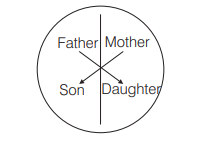
Question
Pick out the correct statements. [NEET 2016, Phase I]
I. Haemophilia is a sex-linked recessive disease.
II. Down’s syndrome is due to aneuploidy.
III. Phenylketonuria is an autosomal recessive gene disorder.
IV. Sickle-cell anaemia is an $\mathrm{X}$ linked recessive gene disorder.
(a) II and IV are correct
(b) I, III and IV are correct
(c) I, II and III are correct
(d) I and IV are correct
Answer/Explanation
Ans. (c)
Sickle-cell anaemia is an autosomal recessive gene disorder in which sickle-celled RBCs are formed instead of normal ones. They carry very less content of $\mathrm{O}_2$ as their haemoglobin is malformed. The person suffering from this disease show symptoms of anaemla.
Question
If a colourblind man marries a woman who is homozygous for normal colour vision, the probability of their son being colourblind is [NEET 2016, Phase II]
(a) 0
(b) $0.5$
(c) $0.75$
(d) 1
Answer/Explanation
Ans. (a)
If a colourblind man marries a woman who is homozygous for normal colour vision, the probability of their son being colourblind is zero. Colour blindness is a recessive sex-linked trait in which the eye fails to distinguish between red and green colour. In females, colour blindness appears only when both sex chromosomes carry recessive gene $\left(X^C X^C\right)$. However, in human males, the defect appears due to single recessive gene $\left(X^c Y\right)$ because $Y$ chromosome does not carry gene for colour vision. This disease shows criss-cross inheritance.
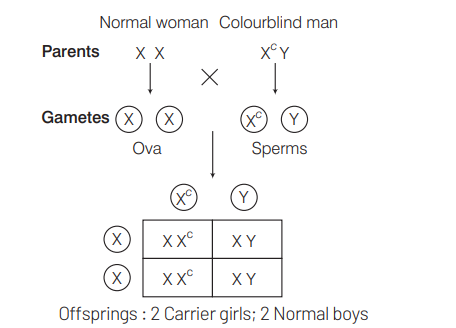
Thus, there is zero probability of son being colourblind. Hence, option (a) is correct.
Question
In the following human pedigree, the filled symbols represent the affected individuals. Identify the type of given pedigree. [CBSE AIPMT 2015]
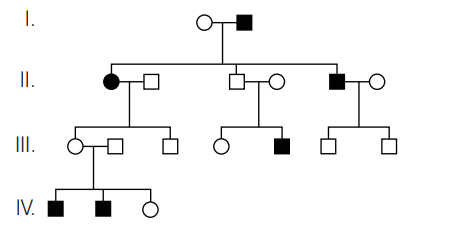
(a) Autosomal dominant
(b) X-linked recessive
(c) Autosomal recessive
(d) X-linked dominant
Answer/Explanation
Ans. (c)
The given pedigree shows the autosomal recessive disorder.
In this disorder, the individual inherit two mutated genes, one from each parent.
This disorder is usually passed on by two carriers. Health is rarely affected, but individual have one mutated gene (recessive gene) and one normal gene (dominant gene) for the condition.
The carriers have a $25 \%$ chance of having an unaffected child with normal genes, $50 \%$ chance of having an unaffected child who also is a carrier and a $25 \%$ chance of having an affected child with recessive genes.
Question
A colourblind man marries a woman with normal sight who has no history of colour blindness in her family. What is the probability of their grandson being colour blind? [CBSE AIPMT 2015]
(a) $0.5$
(b) 1
(c) Nil
(d) $0.25$
Answer/Explanation
Ans. (d)
When a colourblind $\operatorname{man}\left(X^C Y\right)$ marries to a woman with normal sight $(X X)$ who has no family history of colour blindness, all of their sons will be normal pure and all of their daughters will be carriers as shown below
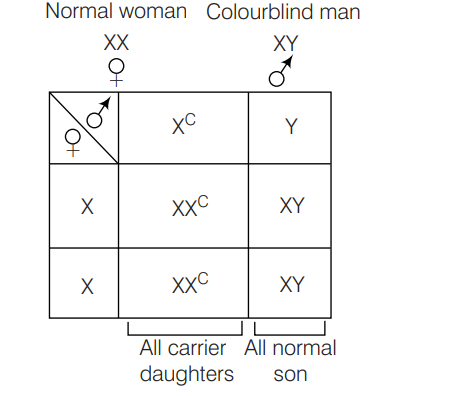
So in the next generation, the children of all of their son will be normal in all conditions (except the case in which the wife involved is not carrier neither colourblind). For carrier daughters.
(i) If they many to a normal man 50%of their grandsons will become colourblind as
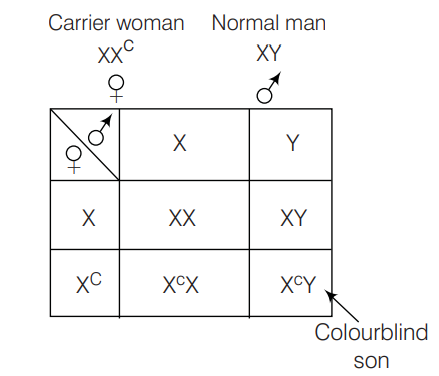
So in both the above cases the result shows 50% of grand sons will be colourblind which in terms of over all progenies (son + daughters) comes as 25% thus confirming the probability as 0.25.
Question
A man whose father was colour blind marries a woman, who had a colour blind mother and normal father. What percentage of male children of this couple will be colour blind? [CBSE AIPMT 2014]
(a) $25 \%$
(b) $0 \%$
(c) $50 \%$
(d) $75 \%$
Answer/Explanation
Ans. (a)
As colour blindness is a sex-linked recessive genetic disorder, for it is present at X-chromosome. Thus, according the gene to the situation given in the question, a man whose father was colour blind (will be, i.e. XY normal) marries a woman whose mother was colourblind and father was normal (i.e. this woman will be a carrier) according to the cross given below
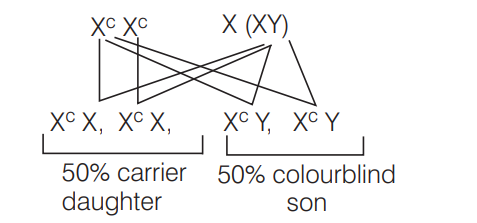
Thus, when marriage will happen between a normal man and a carrier woman, in that case percentage of a male child to be colourblind is 25% (this can be easily observed from the cross given below)
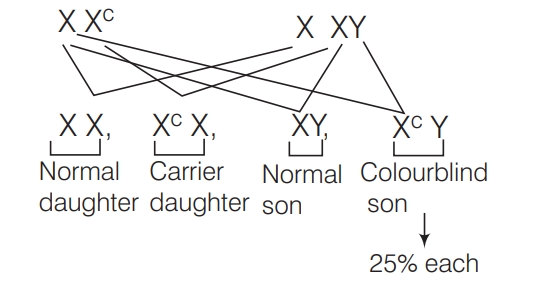
Question
A human female with Turner’s syndrome [CBSE AIPMT 2014]
(a) has 45 chromosomes with XO
(b) has one additional X-chromosome
(c) exhibits male characters
(d) is able to produce children with normal husband
Answer/Explanation
Ans. (a)
A human female with Turner syndrome has the absence of one of the X-chromosome, i.e. 45 with XO (or 44 + XO).Turner syndrome is a chromosomal condition that affects the development in females.
The most common feature of Turner syndrome is short stature, which become evident by the age of 5 . An early loss of ovarian function is also very common.
The ovaries develop normally at first, but egg cells usually die prematurely and most ovarian tissue degenerates before birth.
Question
If both parents are carriers for thalassaemia, which is an autosomal recessive disorder, what are the chances of pregnancy resulting in an affected child? [NEET 2013]
(a) No chance
(b) $50 \%$
(c) $25 \%$
(d) $100 \%$
Answer/Explanation
Ans. (c)
In the given question since both parents carry a haemoglobinopathy trait of thalassemia the risk is $25 \%$ for each pregnancy for an affected child.
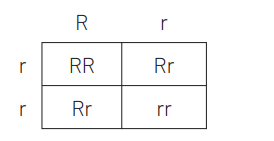
RR–Unaffected (25%)
Rr–Carrier (50%)
rr–Affected (25%)
So, the chances of pregnancy resulting
in an affected child is 25%.
Question
The incorrect statement with regard to haemophilia is [NEET 2013]
(a) it is a sex-linked disease
(b) it is a recessive disease
(c) it is a dominant disease
(d) a single protein involved in the clotting of blood is affected
Answer/Explanation
Ans. (c)
Out of the following statement (c) is incorrect because haemophilia is a sex linked recessive disease. In this disease, a single protein that is a part of the cascade of protein involved in the clotting of blood is affected. The heterozygous female for haemophilia may transmit the disease to sons.
Question
A normal-visioned man whose father was colour blind, marries a woman whose father was also colour blind. They have their first child as a daughter. What are the chances that this child would be colour blind? [CBSE AIPMT 2012]
(a) 100%
(b) 0%
(c) 25%
(d) 50%
Answer/Explanation
Ans. (b)
Colour blindness is an X-linked disease. So, woman whose father was colour blind will be carrier for the disease.
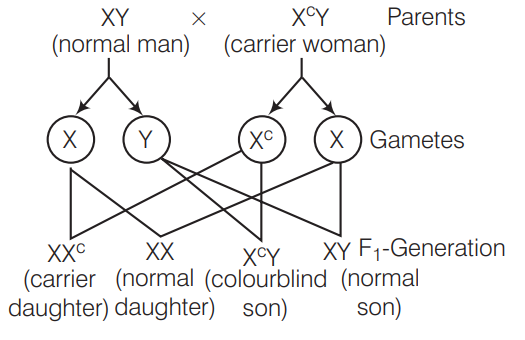
So, possibility of a colour blind daughter (i.e., $X^c X^c$ in $F_1$-generation is $0 \%$.
Question
Which one of the following symbols and its representation, used in human pedigree analysis is correct? [CBSE AIPMT 2010]
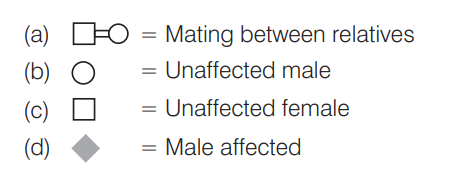
Answer/Explanation
Ans. (a)
The given symbol show the correct representation in human pedigree analysis
![]()
Question
Study the pedigree chart given below.
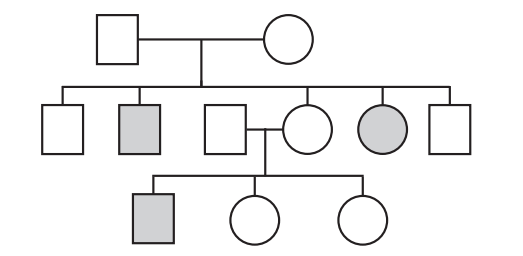
What does it show? [CBSE AIPMT 2009]
(a) Inheritance of a sex-linked inborn error of metabolism like phenylketonuria
(b) Inheritance of a condition like phenylketonuria as an autosomal recessive trait
(c) The pedigree chart is wrong as this is not possible
(d) Inheritance of a recessive sex-linked disease like haemophilia
Answer/Explanation
Ans. (d)
In the given pedigree chart, squares are representing males and circles females. In $F_1$-generation, 1-male and 1-female are diseased and in next generation only male is diseased. This shows the inheritance of a recessive sex-linked disease like haemophilia.
Question
Which one of the following condition in humans is correctly matched with its chromosomal abnormality/linkage? [CBSE AIPMT 2008]
(a) Klinefelter’s syndrome $-44$ autosomes $+X X Y$
(b) Colour blindness – $Y$-linked
(c) Erythroblastosis foetalis- $X$-linked
(d) Down syndrome $-44$ autosomes + XO
Answer/Explanation
Ans. (a)
Klinefelter’s syndrome is represented by 44 autosomes + XXY. When an abnormal egg with XX chromosome is fertilised by a sperm carrying $Y$-chromosome a zygote having XXY sexchromosomes is formed.
The resulting young one is an abnormal sterile male.
The 44 autosome $+\mathrm{XO}$ condition is due to Turner’s syndrome. Such females are sterile and have short stature, webbed neck, broad shield-shaped chest, etc.
Down’s syndrome is due to the trisomy of 21 st pair of chromosome.
It is characterised by moderate mental retardation, large tongue, short stature, stubby fingers, an enlarged liver and spleen.
Colour blindness is an $\mathrm{X}$-linked disease. The person suffering from this disease can’t differentiate between red and green colours.
Erythroblastosis foetalis is caused due to $\mathrm{Rh}$ factor in a child born due to marriage between $\mathrm{Rh}^{+}$man and $\mathrm{Rh}^{-}$ woman.
Question
A man and a woman, who do not show any apparent signs of a certain inherited disease, have seven children ( 2 daughters and 5 sons). Three of the sons suffer from the given disease but none of the daughters are affected. Which of the following mode of inheritance do you suggest for this disease? [CBSE AIPMT 2005]
(a) Autosomal dominant
(b) Sex-linked dominant
(c) Sex-limited recessive
(d) Sex-linked recessive
Answer/Explanation
Ans. (d)
In given problem, disease is the result of sex-linked recessive genes. As neither man nor woman shows signs of disease it means woman would be carrier for disease. In their children none of the daughters suffer from disease, while the sons were sufferred, it means daughters are also carrier (i.e. X-linked recessive).
Suppose, genotype of man $=X Y$
Genotype of woman $=X^d X$
(d-disease causing gene)
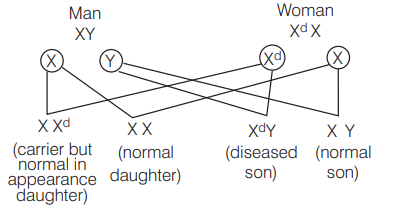
For each delivery the probability for each combination is 25%. So, among seven children 2 normal daughter, 3 diseased sons and 2 normal sons are possible.
Question
Haemophilia is more commonly seen in human males than in human females because [CBSE AIPMT 2005]
(a) this disease is due to an X-linked dominant mutation
(b) a greater proportion of girls die in infancy
(c) this disease is due to an X-linked recessive mutation
(d) this disease is due to a Y-linked recessive mutation
Answer/Explanation
Ans. (c)
Haemophilia, a hereditary (recessive X-linked) disease is caused due to fault in genes controlling the factor VIII and IX, located on X-chromosome. The male carries only one X-chromosome, other sex chromosome carries no genes for blood clotting, so the condition is usually seen only in males where only one faulty chromosome is needed.
While a female with one faulty $X$-chromosome will be carrier. So, in females two faulty X-chromosomes are needed to cause the disease.
Question
A woman with normal vision, but whose father was colour blind, marries a colour blind man. Suppose that the fourth child of this couple was a boy. This boy
[CBSE AIPMT 2005]
(a) must have normal colour vision
(b) will be partially colour blind since he is heterozygous for the colour blind mutant allele
(c) must be colour blind
(d) may be colour blind or may be of normal vision
Answer/Explanation
Ans. (d)
A woman, whose father was colour blind, will be carrier for colour blind trait. Marriage of this woman with a colour blind man will result into following possibilities.
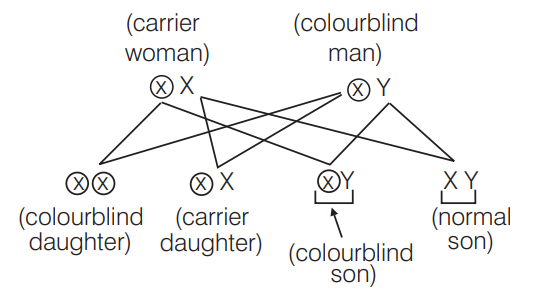
Question
A normal woman whose father was colour blind is married to a normal man. The sons would be [CBSE AIPMT 2004]
(a) $75 \%$ colour blind
(b) $50 \%$ colour blind
(c) all normal
(d) all colour blind
Answer/Explanation
Ans. (b)
The genotype of normal woman with colour blind father $=X X^c$ The genotype of normal $\mathrm{man}=X Y$
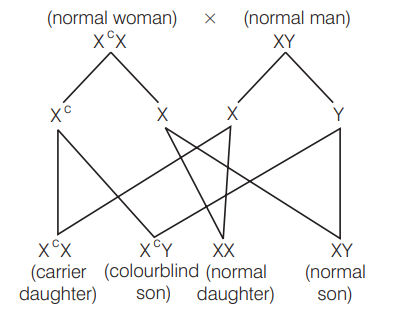
∴ 50% of the sons would be colour blind. Refer Ans 32.
Question
Down’s syndrome is caused by an extra copy of chromosome number 21. What percentage of offspring produced by an affected mother and a normal father would be affected by this disorder? [CBSE AIPMT 2003]
(a) $50 \%$
(b) $25 \%$
(c) $100 \%$
(d) $75 \%$
Answer/Explanation
Ans. (a)
In the given question $50 \%$ of offsprings would be affected by this disorder because Down’s syndrome is the result of trisomy, in which chromosome pair number 21 st contains an extra copy of chromosome $(2 A+1)$. Affected mother will produce $50 \%$ normal egg cells and rest $50 \%$ eggs are of abnormal type.
Question
Which one of the following conditions though harmful in itself, is also a potential saviour from a mosquito borne infectious disease? [CBSE AIPMT 2003]
(a) Pernicious anaemia
(b) Leukaemia
(c) Thalassemia
(d) Sickle-cell anaemia
Answer/Explanation
Ans. (d)
Sickle-cell anaemia is a genetic disorder in which abnormal haemoglobin is formed because valine replaces glutamic acid at the sixth position in $\beta$-chain of haemoglobin, but the persons having this disease do not suffer from malaria as the parasite fails to thrive in sickle-shaped RBCs.
Question
If a diploid cell is treated with colchicine then it becomes [CBSE AIPMT 2002]
(a) triploid
(b) tetraploid
(c) diploid
(d) monoploid
Answer/Explanation
Ans. (b)
Cholchicum outumnale provides an alkaloid called colchicine which is used in plant breeding for doubling the chromosome number. Treatment with $0.1 \%$ colchicine inhibits spindle formation so that chromatids fail to separate during anaphase.
Question
Which of the following is the example of sex-linked disease? [CBSE AIPMT 2002]
(a) AlDS
(b) Colour blindness
(c) Syphilis
(d) Gonorrhoea
Answer/Explanation
Ans. (b)
Colour blindness and haemophilia are well known examples of sex-linked diseases.
Question
Pleiotropic gene is [CBSE AIPMT 2002]
(a) haemophilia
(b) thalassemia
(c) sickle-cell anaemia
(d) colour blindness
Answer/Explanation
Ans. (c)
The ability of a gene to affect an organism in many ways is called pleiotropy (Gr. Pleion – more) and that gene is called as pleiotropic gene, e.g. individuals heterozygous for the sickle-cell anaemia $\left(\mathrm{Hb}^{\wedge} \mathrm{Hb}^5\right)$ are resistant to malaria.
Question
Number of Barr bodies in XXXX female [CBSE AIPMT 2001]
(a) 1
(b) 2
(c) 3
(d) 4
Answer/Explanation
Ans. (c)
The number of Barr bodies in $X X C X X$ female are 3 . Barr body is a condensed mass of chromatin found in the nuclei of placental mammals which contain one or more X-chromosomes, so named after its discoverer Murray Barr. The number of Barr bodies is one less than the number of $X$-chromosomes present.
Question
Haemophilic man marries a normal woman. Their offspring will be [CBSE AIPMT 1999]
(a) all boys haemophilic
(b) all normal
(c) all girls haemophilic
(d) all haemophilic
Answer/Explanation
Ans. (b)
Haemophilia is also a sex-linked recessive disease (like colour blindness). None of the children would suffer from haemophilia, though girls would be carriers of the disease.
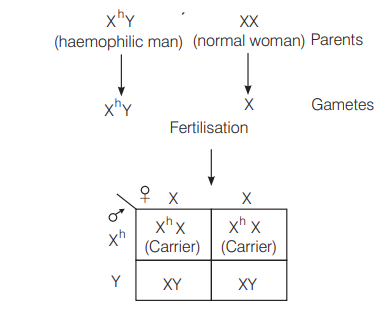
Results : All daughters are carrier while all sons are normal.
Question
A woman with two genes (one on each X-chromosome) for haemophilia and one gene for colour blindness on the X-chromosomes marries a normal man. How will the progeny be? [CBSE AIPMT 1998]
(a) All sons and daughters haemophilic and colour blind
(b) Haemophilic and colour blind daughters
(c) $50 \%$ haemophilic colour blind sons and $50 \%$ haemophilic sons
(d) $50 \%$ haemophilic daughters and $50 \%$ colour blind daughters
Answer/Explanation
Ans. (c)
Haemophilia and colour blindness both are recessive X-linked traits. They express in males when present in single copy (heterozygous) but in females they express only when present in homozygous condition.
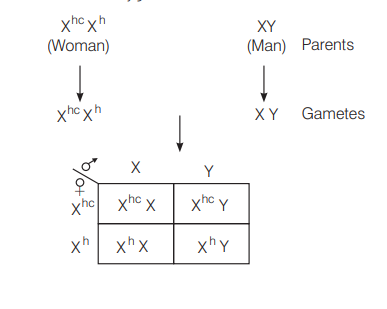
Results
(a) $50 \%$ sons are colour blinds and haemophilic.
(b) $50 \%$ sons are haemophilic only.
(c) $50 \%$ daughters are carrier for colour blindness and haemophilia.
(d) $50 \%$ daughters are carrier for haemophilia only.
Question
Mental retardation in man. associated with sex chromosomal abnormality is usually due to [CBSE AIPMT 1998]
(a) reduction in X-complement
(b) increase in $X$-complement
(c) moderate increase in $Y$-complement
(d) large increase in $Y$-complement
Answer/Explanation
Ans. (b)
Sterile males with undeveloped testes, mental retardation, etc. are due to increase in their X-complement which takes place in a disorder called.
Klinefelter’s syndrome. These are formed by union of an XX egg and a normal $Y$ sperm or normal $X$ egg and abnormal XY sperm. The individual thus has 47 chromosomes $(44+X X Y)$.
Question
A man with a certain disease marries a normal woman. They have eight children ( 3 daughters and 5 sons). All the daughters suffer from their father’s disease but none of the sons are affected. Which of the following mode of inheritance do you suggest for this disease? [CBSE AIPMT 1996, 2002]
(a) Sex-linked recessive
(b) Sex-linked dominant
(c)Autosome dominant
(d) Sex-limited recessive
Answer/Explanation
Ans. (b)
Daughters have $2 \mathrm{X}$-chromosomes one of them is from father and other comes from mother, in this case all the daughters are suffering from the fathers disease hence, X-chromosome of father must be carrying a dominant trait, i.e. inheritance pattern is sex-linked dominant.
Question
A person with 47 chromosomes due to an additional Y-chromosome suffers from a condition called [CBSE AIPMT 1996, 97]
(a) Down’s syndrome
(b) Super female
(c) Turner’s syndrome
(d) Klinefelter’s syndrome
Answer/Explanation
Ans. (d)
HF Klinefelter first descriherl this condition in 1942. The chromosome number is $2 n=47$ with the formula $44 A+X X Y$. Phenotypically these individuals are males, but they can show some female secondary sexual characteristics and are usually sterile.
Question
A woman with albinic father marries an albinic man. The proportion of her progeny is [CBSE AIPMT 1994]
(a) 2 normal : 1 albinic
(b) all normal
(c) all albinic
(d) 1 normal : 1 albinic
Answer/Explanation
Ans. (d)
Daughter of an albinic father will be carrier of this disease, when such woman gets married to an albinic man, $50 \%$ of her progeny will be normal and $50 \%$ will be albinic.
Question
A colourblind woman marries a normal visioned male. In the offspring [CBSE AIPMT 1994]
(a) both son and daughter are colour blind
(b) all daughters are colour blind
(c) all sons are normal
(d) all sons are colour blind
Answer/Explanation
Ans. (d)
When a colour blind woman marries a normal visioned male, daughters will be carrier for this disease and all sons will be colour blind, this can be represented as follows
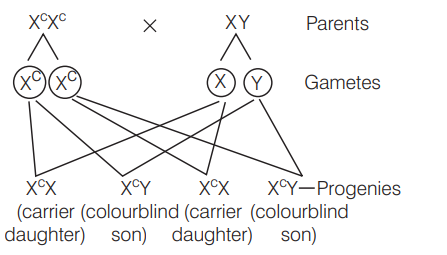
Question
Of both normal parents, the chance of a male child becoming colour blind are [CBSE AIPMT 1993]
(a) no
(b) possible only when all the four grand parents had normal vision
(c) possible only when father’s mother was colour blind
(d) possible only when mother’s father was colour blind
Answer/Explanation
Ans. (d)
Colour blindness is a X-linked recessive disease and the chance of a male child becoming colour blind of a normal parents is only when mother’s father was colour blind.
This is criss-cross inheritance in which genes are transferred to a child from his maternal grandfather through his mother.
Question
Of a normal couple, half the sons are haemophilic while half the daughters are carriers. The gene is located on [CBSE AIPMT 1993]
(a) X-chromosome of father
(b) Y-chromosome of father
(c) one X-chromosome of mother
(d) both the X-chromosomes of mother
Answer/Explanation
Ans. (c)
Haemophilia is a sex-linked disease. Gene of this disease is located on X-chromosome. In the given case where half the sons are haemophilic and half the daughters are carriers this is possible only when the gene responsible for haemophilia is located on one X-chromosome of mother.
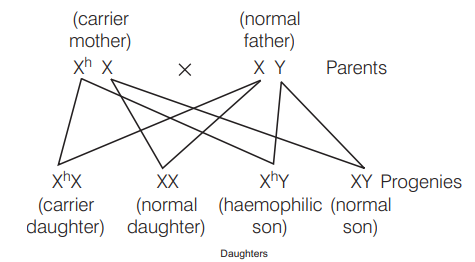
$50 \%=$ Carrier,$\quad 50 \%=$ Normal
Sons
$50 \%=$ Haemophilic, $50 \%=$ Normal
Question
In human beings 45 chromosomes/single $X / X O$ abnormality causes [CBSE AIPMT 1992]
(a) Down’s syndrome
(b) Klinefelter’s syndrome
(c) Turner’s syndrome
(d) Edward’s syndrome
Answer/Explanation
Ans. (c)
In human beings 45 chromosomes/XO abnormality causes Turner’s syndrome. Henery H Turner first described this condition in 1938. Chromosomal formula is $44+X 0$. Phenotypically these individuals are females but ovaries are rudimentary and always sterile.
Question
A colourblind mother and normal father would have [CBSE AIPMT 1992, 99, 2006]
(a) colour blind sons and normal/carrier daughters
(b) colour blind sons and daughters
(c) all colour blind
(d) all normal
Answer/Explanation
Ans. (a)
A colourblind mother and normal father would have colour blind sons and carrier daughters. Daughters will be normal phenotypically but they will be carrier genotypically.
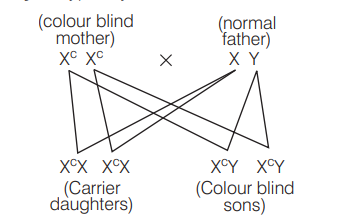
Question
Down’s syndrome is due to [CBSE AIPMT 1992, 2000, 02, 03]
(a) crossing over
(b) linkage
(c) sex-linked inheritance
(d) non-disjunction of chromosomes
Answer/Explanation
Ans. (d)
Non-disjunction of 21st chromosome during oogenesis is the cause of Down’s syndrome. It is also called mongolian syndrome.
Question
A colourblind girl is rare because she will be born only when [CBSE AIPMT 1991]
(a) her mother and maternal grandfather were colourblind
(b) her father and maternal grandfather were colourblind
(c) her mother is colour blind and father has normal vision
(d) parents have normal vision but grand parents were colourblind
Answer/Explanation
Ans. (b)
For a girl to be colourblind, the genotype of her father should be $X^C Y$ and of her mother either $X^C X$ or $X^C X^C$, where $X^C$ represents colour blind gene. In the given options this is only possible when her father and maternal grandfather were colour blind.
Question
Which one is a hereditary disease? [CBSE AIPMT 1990]
(a) Cataract
(b) Leprosy
(c) Blindness
(d) Phenylketonuria
Answer/Explanation
Ans. (d)
Phenylketonuria was discovered by the Norwegian physician A Fooling in 1934, an autosomal recessive mutation of gene on chromosome 12 .
Phenylketonuria results when there is a deficiency of liver enzyme phenylalanine hydroxylase that converts phenylalanine into tyrosine. Increased phenylalanine in the blood interferes with brain development, muscles and cartilage of the legs may be defective and the patients cannot walk properly.
Question
Haemophilia is more common in males because it is a [CBSE AIPMT 1990]
(a) recessive character carried by Y-chromosome
(b) dominant character carried by Y-chromosome
(c) dominant trait carried by X-chromosome
(d) recessive trait carried by X-chromosome
Answer/Explanation
Ans. (d)
Haemophilia is a disorder, which is sex-linked (X-chromosome) recessive condition. Males have only one $X$-chromosome, so this disease appears in them more then female as they have $2 \mathrm{X}$-chromosomes.
Question
Both husband and wife have normal vision though their fathers were colour blind. The probability of their daughter becoming colourblind is [CBSE AIPMT 1990]
(a) $0 \%$
(b) $25 \%$
(c) $50 \%$
(d) $75 \%$
Ans. (a)
Answer/Explanation
Ans. (a)
In this case when the fathers of both husband and wife were colour blind and they have normal vision, husband have normal vision while wife is carrier of this disease. Daughter of such parents will be carrier but there is no chance of her to be colour blind.
Question
In Down’s syndrome of a male child, the sex complement is [CBSE AIPMT 1990]
(a) $\times 0$
(b) $X Y$
(c) $X X$
(d) $X X Y$
Answer/Explanation
Ans. (b)
$X Y$ is the sex complement of a male child with Down’s syndrome. The cause of Down’s syndrome is non-disjunction of 21 st chromosome during oogenesis. This chromosomal abnormality is related with autosome so, the sex complement of a male child in this syndrome will be $X Y$.
